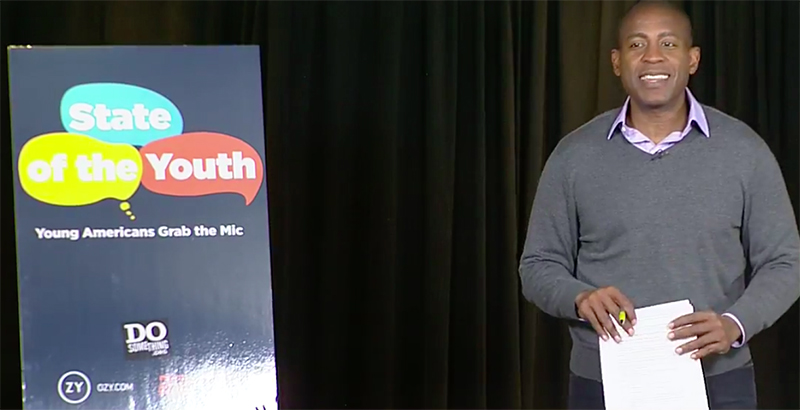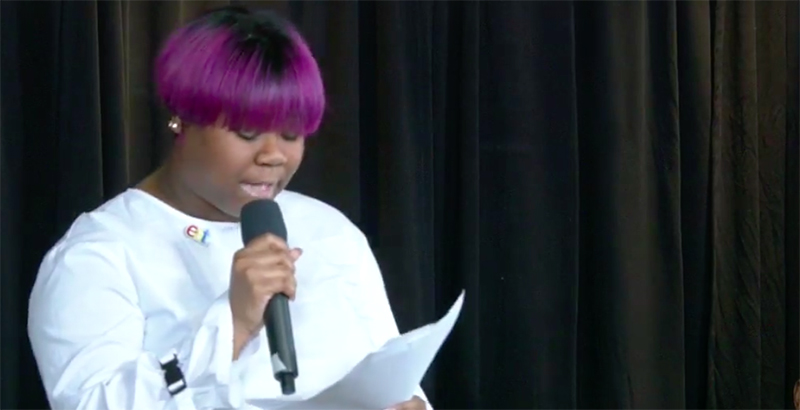‘It Only Gets Better From Here’: After State of the Union, Students Stage ‘State of the Youth’

Washington, D.C.
President Donald Trump’s State of the Union address Tuesday touched on issues important to his base: a new infrastructure plan, the recently passed tax reform plan, tough talk against North Korea.
But it was a far cry from the issues young people emphasized at a separate “State of the Youth” event the next evening.
Two panels of young people — college students and one recent graduate, and a group of high school and middle school students — spoke to about six dozen of their peers Wednesday evening at the Newseum in Washington, an event organized by DoSomething.org, the news organization OZY, and 22×20, a group that aims to get the 22 million teens who will be 18 by the 2020 elections registered as voters and involved in politics.
Whereas Trump, for instance, called for curbs on legal immigration, one young person advocated the legalization of all 11 million undocumented people in the country already.

Another called for passage of laws banning discrimination in the workplace and housing based on sexual orientation or gender identity; Trump’s administration overturned federal protections for transgender students and created a “religious freedom” health office that advocates say could jeopardize care for LGBT people.
Trump in his speech celebrated the repeal of “the core of disastrous Obamacare,” the mandate that everyone buy health insurance.
Rebecca Thimmesch, a college senior whose political advocacy dates to her interning on political campaigns at age 12, said universal health care would be her top priority.
“It’s not just enough to say everyone is going to have health insurance, because there are communities in the United States that don’t have adequate health care providers,” she said. She pointed to the recent closure of the maternity ward in the only hospital in D.C.’s two poorest neighborhoods.
The gap between Trump’s speech and the young people’s priorities perhaps isn’t a surprise: Hillary Clinton beat Trump by 19 points among voters under 30, the largest gap of any age group. The president’s approval rating with that same group was 30 percent at the end of last year, nine points below his approval among Americans of all ages, according to Gallup.
Brittany Packnett, an executive at Teach for America, activist, and protester in Ferguson, Missouri, encouraged the young crowd to participate in American democracy, particularly by voting.
“We have to ask ourselves, if voting didn’t matter, why are people still working so hard to keep us from it?” she said, citing changes in state voter registration and identification laws and closures of polling places in communities of color, in low-income neighborhoods, and on college campuses.
Young people have a rich history in expanding voting rights, particularly during the civil rights movement, and it was an eighth-grader who encouraged Packnett to keep protesting in Ferguson, even after police teargassed those who were peacefully assembled.
Packnett said she wasn’t particularly invested in voting when she was a teenager until the election of 2000, when her preferred candidate, Al Gore, lost, after months of drama in Florida surrounding disputed ballots.
“I had to be clear that no one would ever make a decision about me without me… It’s one thing to know that a change needs to come. It’s another to step up and participate in making the change,” she said.
Thimmesch, the college senior, said young people are prepared to tackle big issues and conversations about privilege and social equity that older generations aren’t.
Young people also have fewer problems to unlearn than older people, she said, citing her positive work with teenage activists.
“I think that it only gets better from here,” she said.
Get stories like these delivered straight to your inbox. Sign up for The 74 Newsletter

;)
